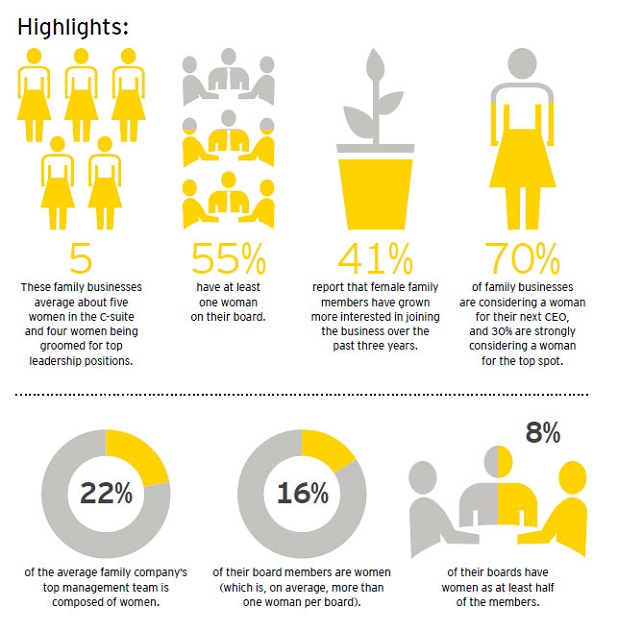Women in leadership: EY Study
The largest, longest-lasting family businesses in the world are moving women further and doing so faster than their non-family counterparts. Why is this important? Because these businesses are the anchors of the world economy.
Family businesses as a whole create an estimated 70%–90% of the global GDP and 50%–80% of jobs in the majority of countries worldwide. They employ vast numbers of people, dominate key markets and are intrinsically important to their local communities and global economies — and have been for generations.
“Family businesses may offer a path forward for all businesses seeking to achieve gender parity within their leadership ranks,” said Carrie Hall, EY Americas Family Business Leader. “Our analysis of this data suggests that inherent traits of successful family businesses contributing to their long-term success also create an environment that’s more welcoming and conducive to the development of women leaders.”
Highlights from family business survey
Women in family business: not just a family affair
Our research shows that family businesses believe in the value of women in leadership overall, not only women family members.
For instance, while the companies in our survey averaged 1.14 women family members in leadership (i.e., C-level positions/officers of the company, including vice presidents), they also averaged 3.5 women in the C-suite who were not family members.
Furthermore, they are grooming an average of four women for these top leadership positions: one family member and three non-family members.
What is it about the world’s largest and longest-lasting family businesses that has led them to embrace women in leadership?
Overall, our analysis suggests that inherent traits of successful family businesses that contribute to their long-term success also create an environment that’s more welcoming and conducive to the development of women leaders.
A formula for success
- Role models. Family businesses that tend to have women in top leadership in the C-suite and on the board offer role models to less-senior women and clearly demonstrate that moving up the ranks and assuming leadership positions are possible.
- Long-term thinking. Family businesses tend to think in very long time horizons. The ultimate goal, typically, is a sustainable enterprise that serves the family and the business well, using growth as the means to that end. This long-term thinking and longevity contribute to the erosion of conscious and unconscious bias, making space for women at the top.
- Inclusive environment. Family businesses balance the interests of the family with the needs of the business by emphasizing cohesiveness, inclusiveness and commitment to the well-being and wealth of the family and the family enterprise, including non-family employees. In short, people — not just profits — matter. This is the kind of environment in which women thrive.
A pattern of success
- Companies that seek to achieve the competitive advantage that comes with gender parity should emulate these family business traits:
- Establish a clear path for women to move into leadership roles with more female role models
- Pursue a long-term, sustainable growth strategy
- Create a cohesive, inclusive environment focused more on people and less on achievement of short-term financial results





Share
Facebook
YouTube
Tweet
Twitter
LinkedIn